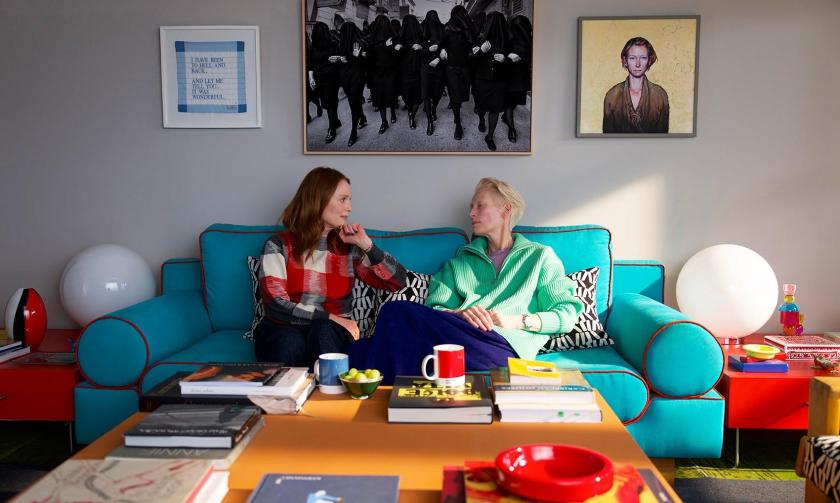Towards the end of the last century, the Spanish director Pedro Almodóvar made a run of screwball comedies, starting with Women on the Verge of a Nervous Breakdown (1988) and Tie Me Up! Tie Me Down! (1989), and ending with All About My Mother (1999), that were full of life, language and the aberrant behaviour of strong female characters.
In his new movie, The Room Next Door, his first full-length feature in English – adapted from the novel What Are You Going Through by Sigrid Nunez – the two main characters are once again a pair of indomitable women facing up to a crisis, but somehow both life and language seem to have drained out of a film whose mournful subject is the shadow of death.
Ingrid (Julianne Moore, pictured below right), a best-selling author with a dread of mortality, is signing copies of her latest novel in a Manhattan bookshop when she learns that a long-lost friend has been hospitalised with cancer. The woman on the verge of death is a former war reporter called Martha, played by Tilda Swinton (“I’m just a journalist addicted to war as adrenalin”), who has procured an illegal euthanasia pill and now wants Ingrid to be present in the room next door when she takes it. “I think I deserve a good death,” she tells her friend.
The film, which won the Golden Lion at this year’s Venice Film Festival, could hardly be more topical in the face of the urgent real-world debate about assisted dying. The awkwardness of semi-estrangement melts as the women leave New York and head to a luxury modernist rental near Woodstock to begin Martha’s final journey. As you would expect from a filmmaker strongly associated with background and costume and production design, the visual control of the film is dazzling. Along with Bina Daigeler’s eye-catching red, azure, and magenta costumes, and Inbal Weinberg’s meticulously dressed sets, the director’s trademark attention to symmetry and colour gives shape to the women’s interior lives.
 The Room Next Door is a very Almodóvarian mixture of real and emotional weather – which is to say, it’s not entirely realistic. In one scene, tucked away in the Woodstock woods, for example, cinematographer Eduard Grau’s camera follows the protagonists outside as they sunbathe on upholstered deckchairs, mirroring a copy of Edward Hopper’s People in the Sun on the wall of the rented house.
The Room Next Door is a very Almodóvarian mixture of real and emotional weather – which is to say, it’s not entirely realistic. In one scene, tucked away in the Woodstock woods, for example, cinematographer Eduard Grau’s camera follows the protagonists outside as they sunbathe on upholstered deckchairs, mirroring a copy of Edward Hopper’s People in the Sun on the wall of the rented house.
In the next scene, the two friends shelter inside from a blizzard – “Pink snowflakes, there had to be something good about climate change!” Martha sighs, before quoting the last lines of James Joyce’s The Dead, in which the hero listens to snow “falling faintly through the universe and faintly falling, like the descent of their last end, upon all the living and the dead.”
That passage, inevitably followed by a clip from John Huston’s film of Joyce’s story, highlights the main problem with The Room Next Door. The habitual stylisation of Almodóvar’s dialogue, written in Spanish, does not straightforwardly translate into English without sounding clunky and inauthentic. As a result, many of the scenes between Martha and Ingrid feel desperately stilted, as if the characters were speaking an invented language like Esperanto or parroting extracts from books.
“I’m doing research on the painter Dora Carrington and her intense relationship with the writer Lytton Strachey,” Ingrid says at one point before recapping Carrington’s unrequited love for Strachey, her marriage to Ralph Partridge and their lopsided ménage à trois, and her suicide two months after Lytton’s death from cancer. But Ingrid’s research can’t have got very far because she’s yet to learn how to pronounce Strachey’s surname correctly, a jarring note that perhaps an anglophone director might have caught.
Other things don’t translate. For instance, Almodóvar’s last feature Parallel Mothers (2021) was haunted by ghosts of the Spanish civil war. In The Room Next Door, Martha implausibly tells Ingrid her back story – which you’d think an old friend might have known anyway – about an estranged daughter (“I fantasise frequently about her being swapped at birth”) who is haunted by the ghost of her father, a marine who suffered trauma in the Vietnam War. In the earlier film, the narrative control of past and present is spellbinding. Here, as Almodóvar moves backwards and forwards in time, as if shifting the gears at full speed, it just seems headlong and absurd. The director’s unease with America, as with the Bloomsbury Group, is painfully obvious. In fact, the production appears to have been shot mostly in Spain with just second-unit work in New York. As a result, the artificiality of the setting, as well as of the dialogue, constantly jolts the film out of its story.














Add comment